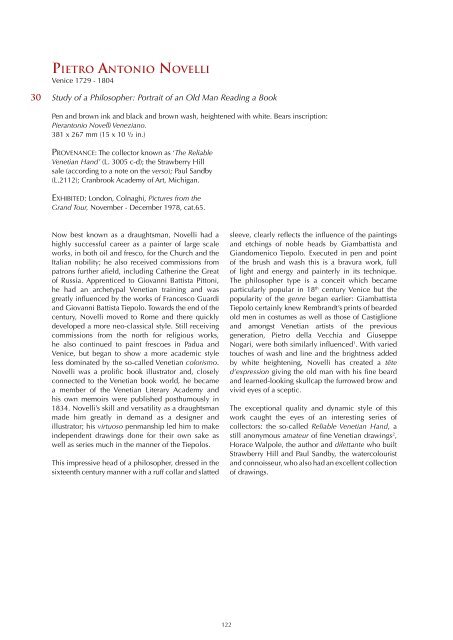Create successful ePaper yourself
Turn your PDF publications into a flip-book with our unique Google optimized e-Paper software.
Pietro Antonio Novelli<br />
Venice 1729 - 1804<br />
30<br />
Study of a Philosopher: Portrait of an Old Man Reading a Book<br />
Pen and brown ink and black and brown wash, heightened with white. Bears inscription:<br />
Pierantonio Novelli Veneziano.<br />
381 x 267 mm (15 x 10 ½ in.)<br />
Provenance: The collector known as ‘The Reliable<br />
Venetian Hand’ (L. 3005 c-d); the Strawberry Hill<br />
sale (according to a note on the verso); Paul Sandby<br />
(L.2112); Cranbrook Academy of Art, Michigan.<br />
Exhibited: London, Colnaghi, Pictures from the<br />
Grand Tour, November - December 1978, cat.65.<br />
Now best known as a draughtsman, Novelli had a<br />
highly successful career as a painter of large scale<br />
works, in both oil and fresco, for the Church and the<br />
Italian nobility; he also received commissions from<br />
patrons further afield, including Catherine the Great<br />
of Russia. Apprenticed to Giovanni Battista Pittoni,<br />
he had an archetypal Venetian training and was<br />
greatly influenced by the works of Francesco Guardi<br />
and Giovanni Battista Tiepolo. Towards the end of the<br />
century, Novelli moved to Rome and there quickly<br />
developed a more neo-classical style. Still receiving<br />
commissions from the north for religious works,<br />
he also continued to paint frescoes in Padua and<br />
Venice, but began to show a more academic style<br />
less dominated by the so-called Venetian colorismo.<br />
Novelli was a prolific book illustrator and, closely<br />
connected to the Venetian book world, he became<br />
a member of the Venetian Literary Academy and<br />
his own memoirs were published posthumously in<br />
1834. Novelli’s skill and versatility as a draughtsman<br />
made him greatly in demand as a designer and<br />
illustrator; his virtuoso penmanship led him to make<br />
independent drawings done for their own sake as<br />
well as series much in the manner of the Tiepolos.<br />
This impressive head of a philosopher, dressed in the<br />
sixteenth century manner with a ruff collar and slatted<br />
sleeve, clearly reflects the influence of the paintings<br />
and etchings of noble heads by Giambattista and<br />
Giandomenico Tiepolo. Executed in pen and point<br />
of the brush and wash this is a bravura work, full<br />
of light and energy and painterly in its technique.<br />
The philosopher type is a conceit which became<br />
particularly popular in 18 th century Venice but the<br />
popularity of the genre began earlier: Giambattista<br />
Tiepolo certainly knew Rembrandt’s prints of bearded<br />
old men in costumes as well as those of Castiglione<br />
and amongst Venetian artists of the previous<br />
generation, Pietro della Vecchia and Giuseppe<br />
Nogari, were both similarly influenced 1 . With varied<br />
touches of wash and line and the brightness added<br />
by white heightening, Novelli has created a tête<br />
d’expression giving the old man with his fine beard<br />
and learned-looking skullcap the furrowed brow and<br />
vivid eyes of a sceptic.<br />
The exceptional quality and dynamic style of this<br />
work caught the eyes of an interesting series of<br />
collectors: the so-called Reliable Venetian Hand, a<br />
still anonymous amateur of fine Venetian drawings 2 ,<br />
Horace Walpole, the author and dilettante who built<br />
Strawberry Hill and Paul Sandby, the watercolourist<br />
and connoisseur, who also had an excellent collection<br />
of drawings.<br />
122
















